|
|
| 'Like' us on Facebook | Follow us: |
Posted on: June 13, 2015
 |
 |
Part 01 || Part 02 || Part 03 || Part 05 || Part 06
Loving Sai Ram and greetings from Prasanthi Nilayam.
Last time, I spoke to you mainly about Atmadharma. As a concept, it is very old but keeping in mind the fact that you might be hearing about it for the first time, I took great pains to explain it in as much detail as I could. In spite of that, you are perhaps getting the feeling that this Atmadharma is difficult stuff and not quite meaningful for today’s world. That is one mistake we just cannot afford to make. By way of driving home the fact that Atmadharma is not difficult, Swami says that simple acts that fill our daily life could be made to have a deep relationship to Atmadharma, if only we choose. Is this really possible? That is an important point but I shall discuss that later; for the moment, let us hear what Swami has to say next:
"If, in your daily avocations, you translate the Real Values of Eternal Dharma into love-filled acts, then your duty to the inner Reality, the Atmadharma is also fulfilled. Always build your living on the Atmic Plinth; then, your progress is assured."
Let me restate the above quote somewhat differently, using Swami’s own words, more familiar to us. Does not Swami often tell us: ‘Start the day with Love; fill the day with Love and end the day with Love’? That exactly is what the quote I have offered from Dharma Vahini also says.
Let us now look at this a little more deeply. Take a simple act like worshipping an idol. This is something people still do, even in this internet age. First, let us hear what Swami has to say about that. Listen please.
"Making God into stone - that is the effort being made today! How can such effort lead to Truth, when the real task is to see the stone as God? First, the Form of the Godhead has to be meditated upon and imprinted on the consciousness; then, that Form has to be conceived within the stone and the stone forgotten in the process, until the stone is transformed into God."
Basically, what Swami is saying is that one must see God in stone and NOT make God into stone. This is something we must reflect carefully on. There are two things here – the symbol and the larger concept that the symbol represents. The stone sculpture is the symbol while God is the Fundamental Principle. If people are made to think that God is just the stone idol and nothing else, then it can be quite dangerous. A state of narrow-mindedness can develop wherein the Principle is totally forgotten and one is trapped in not only trivialities but also in dangerous myths, leading in turn to bigotry, hatred etc. I hope to return to this important point later. Meanwhile, let us hear again from Swami:
"In the same way, you have to imprint on your consciousness the basic Dharma, the Fundamental Fact of Atma as the only Entity; and, then, filled with that Faith and Vision, you have to deal with the manifold world of objects, its attractions and impingements. It is only thus that the Ideal can be realised. If this is done, there is no danger of the Authentic Meaning getting diluted, or Atmadharma losing its lustre."
Swami is reminding us that while the Atma is one, it manifests in the universe with incredible diversity; the different entities may appear to have their own distinctive individuality but in truth, they all are the manifestations of One Grand and Universal Principle. It is to highlight this that Swami often tells us: ‘Cows are many but milk is one; jewels are many but gold is one’ and so on.
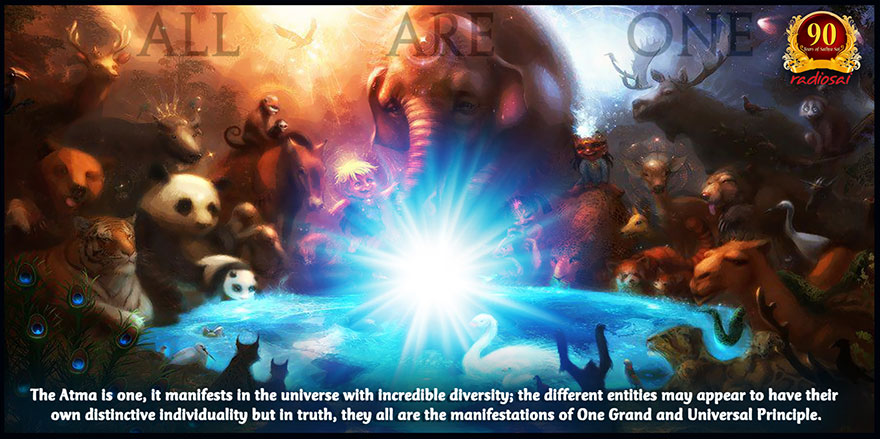 |
Let us dig a bit deeper and consider the statement, ‘Jewels are many but gold is one.’ Suppose, for the sake of argument, the jewels have all been made of copper and simply plated with gold. Clearly the gold-plated jewels would be worth far less than those made with pure gold. In the same way, actions that appear Dharmic but are only superficially so, would be worthless compared to those based on Atmadharma. I mean, suppose a man gives charity of say a million rupees, merely so that his name appears in the newspapers; would that have any spiritual value? None at all; on the other hand, the charity of a hungry beggar who shares his meagre meal with another hungry soul is far superior – that is the point Swami is making.
Back to Swami, and let us hear His next quote.
"What happens when a stone is worshipped as God? The Unlimited, the Ever-present, the All-pervading-immanent Entity, the Absolute, is visualised in the Particular, in the Concrete. Similarly, Dharma, which is Universal, Equal and Free, can be spotted and tested in a single concrete act. Do not be misled by the idea that this is not possible. Are not many things difficult accomplished by you, things that only increase your anxiety and fear? If man is wise, can he not take up instead things that are more worthwhile, which give him peace of mind?"
The basic point Swami is making is simple. He says in effect: “Listen, the devotee may worship an idol, but the idol is simply a device for the devotee to commune with God who is really Infinite. Infinity is a concept difficult for simple folk to grasp but through loving worship of even a symbol, their Love can blossom enormously.” That is the point Swami is really making. Let us try to understand that further.
Say there is this genuine devotee who sees his God say, Krishna, in the beautiful idol he worships lovingly. Let us further suppose that this devotee offers some sweet dish to Krishna, and afterwards shares that lovingly with other devotees as Prasaadam. The devotee’s love for Krishna now spills over to real people, his fellow devotees, and this happens all the time in many ways. In other words, filled with love for Krishna, the devotee is eager to share his love with others at every conceivable opportunity, filled as he is with compassion for those who suffer. The point simply is that while the worship is supposed to be offered to a so-called lifeless idol, the devotee all the time visualises something that the idol represents – namely Krishna, the Embodiment of Divine Compassion, Divine Love, Divine Grace, Divine Security and so on. That is what transforms the devotee. In short, the idol is merely a switch that turns on love and similar virtues in the devotee.
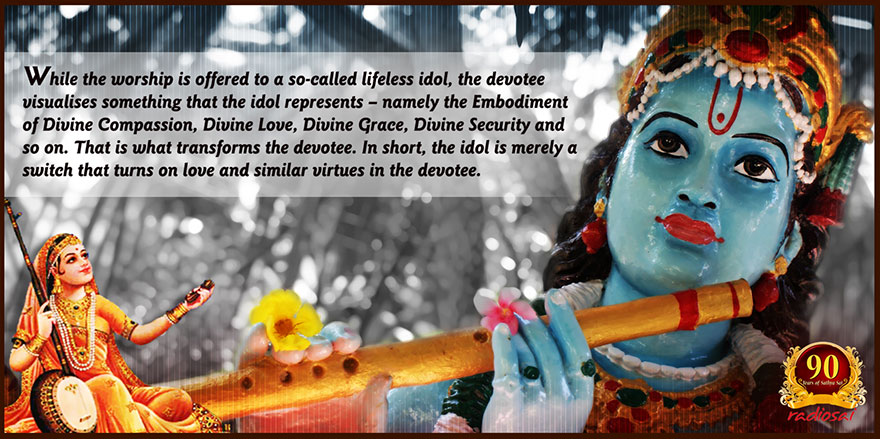 |
Keeping this in mind, let us revisit the quote of Swami that I offered a short while ago, about jewels and gold. Basically, Swami says that the general can be seen in the particular; conversely, the particular must become a symbol of the general. Thus, while Atmadharma might seem a vague and nebulous concept to ordinary folk, even simple people can understand selfless service, compassion, etc. and by engaging in loving and selfless acts such people can, unknown to them, actually practice Atmadharma.
Say there is a hungry old woman shivering in the cold. A person appears and gives the old woman a blanket and also some hot soup. For her, that benefactor is God Himself! In worldly terms, what this old woman sees is merely a human benefactor; however, for that woman, at that moment, what the man is giving is also a manifestation of the love and compassion of God – that is what I mean by seeing the Universal in the particular.
“In short”, says Swami, “don’t get turned off by the jargon. Seeing the Divine even in simple acts is possible and not as difficult as we imagine.” Swami adds, “You handle and face all sorts of difficult challenges in your professional life and at the end of it all, you find yourself drowned in anxiety and tension. If you can take on such difficult tasks why not do something to get more familiar with Atmadharma, which would take you very far indeed?” In other words, if we find Atmadharma to be a difficult concept, it is simply because we are not spending even a minute to understand it; if the effort is made, the concept is actually quite easy to follow.
Let us listen a bit more:
"Therefore, endeavour first to become Free. That is to say, as a preliminary to successful living, cultivate Faith in the Atma as the core of your personality and then learn and practice the discipline necessary to reach down to that core. With that qualification acquired, you can engage fully in worldly activities, following the Dharma prescribed for their regulation. Then you become a moral individual, a Dharma purusha."
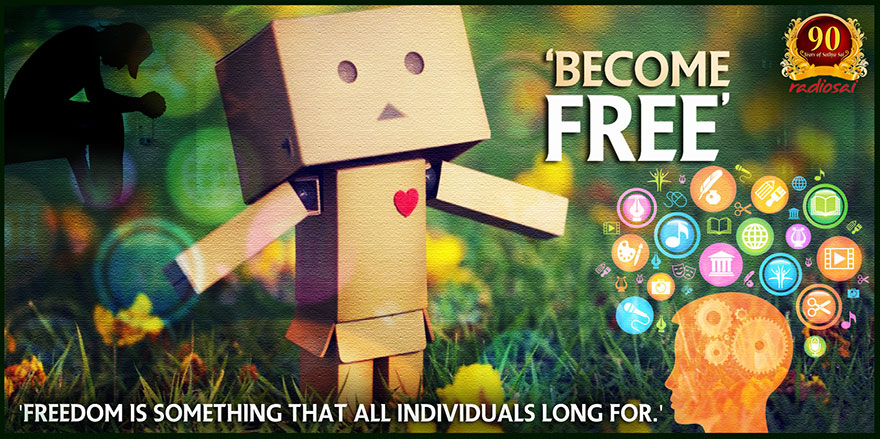 |
I hope you heard that carefully, and locked on to the phrase become Free. That is crucial. Freedom is something that all individuals long for. Normally, people want to be free of things that hold them back in daily life; they may feel cramped due to lack of money, lack of a job, lack of a car and material needs like that. Or else, there could be constraints related to people – it could be a strict father, a nasty mother-in-law, or an equally difficult daughter-in-law, a mean boss, a dictator who is making life into slavery, discrimination of some sort or the other, and so on. Young people all the time feel that they are being constrained by parents, elders, teachers and so on, and want to do the in-thing, and what the media proclaims to be the choice of the peers.
Yes, this is the way humans everywhere normally react to checks and constraints; these are facts of life and cannot be dismissed. However, when Swami is talking of being Free, He is referring something much beyond all these; what Swami is referring to is not well understood, and that is what I want to focus on right now.
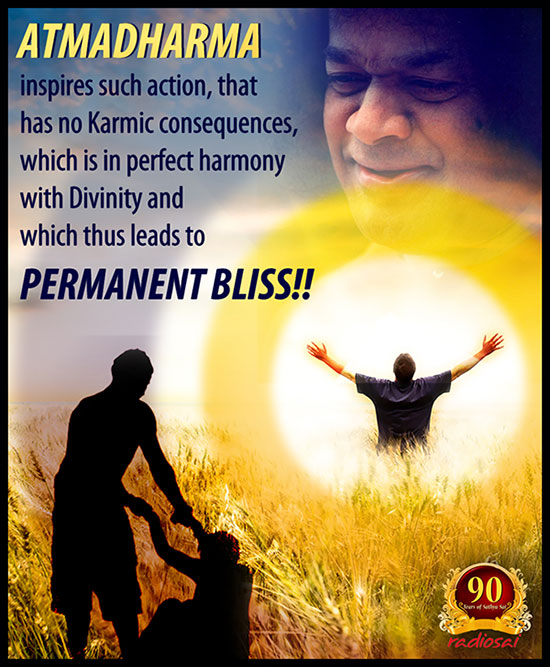 |
You see, where Spirituality is concerned, being Free means something very different from what I have been referring to. I know this would be difficult to understand and so let me take you through all of it slowly. Consider a young person who feels heavily constrained and chocked by social norms of behaviour etc. etc. This young person therefore takes to drugs in order to feel free. Yes, taking drugs does make the person feel high, at least for a while, and when the person is intoxicated, the person does feel he or she is ‘free’. But how long does that feeling last? Not very much; and so this person goes back again to the drugs to get high. And you know what happens after that; pretty soon the person becomes addicted and a SLAVE to the drug. Where is the freedom now? There never was any freedom to start with; it was a mere illusion, that is all. What has happened is that the person mistakenly thought he or she was going to be free by doing something, whereas what was really happening was that the person was actually walking into the trap of bondage!
If you think about it, there are many things that people hanker after, in search of freedom as they see it, be it gambling or drinking or whatever; ultimately, all these pursuits lead them to some kind of bondage; in turn, this leads to depression and alas, sometimes, even to self-destruction. In short, actions that are supposed to set free or be the symbols of freedom [so-called] actually enslave! This is the honest truth, but then truth is so inconvenient to accept that people tend to rubbish such an analysis. Nevertheless, Truth is Truth, however unpleasant it might sound to people who do not wish to face it.
So, what then is real freedom and what does it REALLY mean to be free? Swami has given the answer to that as clearly as one could. It all starts with a simple fact:
A thing is free if there is no price to pay, or there are no consequences to face.
I mean, a person could brag, “I have a gun and I am free to kill!” People do feel this way and also go out and kill, but then most of them get caught, and when that happens, the price extracted is heavy. One can give many such examples and the bottom line is that THERE IS NO SUCH THING AS A FREE LUNCH. You might then ask: “If that is so, what then is truly IS free? What exactly is true freedom?”
Here is the answer.
Freedom is that state wherein the actions that one performs carry NO PRICE AND DO NOT LEAD TO ANY PAINFUL OR UNDESIRABLE CONSEQUENCES. That is what happens when one follows Atmadharma; such an action is in perfect harmony with Divinity and there is no Karma attached to it. On the other hand, such actions lead eventually to union with God and therefore Permanent Bliss. To put it differently, man thinks that yielding to Kama, Krodha etc. is what confers freedom. To say “I am free to follow my desire,” or “I am free to get angry when I like,” etc. is not true freedom. On the contrary, being free from these six deadly enemies is true freedom; it is only in such a state one is free to act in accordance with Atmadharma, and such actions alone do not carry a ‘price tag’. On the other hand, they lead to Eternal Bliss, freeing one for ever from the alternating cycle of pleasure and pain.
To put it simply:
Freedom is when one is able to follow Atmadharma without experiencing the impediments placed by Kama, Krodha, etc.
We get a better insight into all this from the next excerpt. Let us listen. Swami says:
"Those who hold the physical objective world as the all of life and the body as the Self, lead but wasted lives, as meaningless as making God into stone. Making the stone into God is the holier, more wholesome task."
The quote is small but full of meaning; so, let us try and absorb what Swami is saying. First of all, there are two entities - the transient world that appears to be very real, and then something called True Reality, which, to all of us appears very unreal. Yet, according to Spirituality, this other thing that is so intangible is actually Real because it is Eternal!
Used as we are to living very much in the world and being generally very ignorant about the Eternal Atma that is supposed to be our Real Self, we do not believe when we are told about the Atma, True Reality etc. We ask all sorts of questions like: “What is this Atma? We cannot see it and even if it does exist, it does not seem to be relevant to our daily life. Why then bother? What is the big deal?”
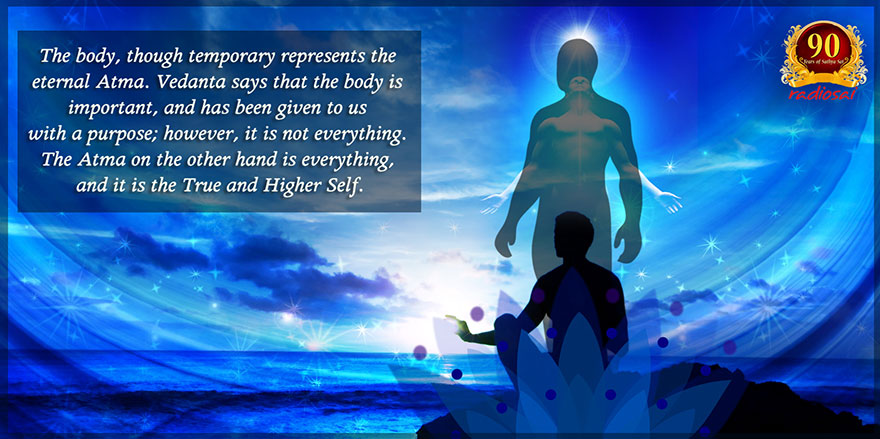 |
It all seems so very puzzling; there is something we see constantly before our eyes, and yet it is declared to be unreal. On the other hand there is something we do not ever see, and yet his unseen is declared to be the True Reality! No wonder it all seems so confusing!
Swami helps us out in the following way. He says [effectively] “Consider a stone idol that is supposed to represent God. Is God just the idol, or is the idol a mere symbol of God? If God is only the idol, then, God is finite; but we know God is not finite. Again, the stone can weather and crumble with age due to thermal cycle and what not. Can God be wiped out by weather? Obviously not.
There is thus a difference between seeing God as only a piece of stone and seeing the stone idol as a representative symbol of God the Eternal, in a transient world.” Hope you get the point, which is that one must not confuse the symbol with what the symbol stands for or represents.
Let us carry over this idea to ourselves. You see, there are really two aspects to our personality, the body and what the body actually represents. The body is the symbol and it is the temporary aspect; therefore, it is not very important. On the other hand, what the body represents is the Eternal Atma, and that is what is important. However, because we cannot see the Atma, we tend to dismiss it totally, and instead regard the body to be our true Self. Vedanta says that is not correct; yes, the body IS important, and has been given to us with a purpose; however, it is not everything; at best the Lower Self. The Atma, on the other hand, is everything and it is the True of the Higher Self.
Thus, to believe that we are merely the Lower Self is as bad as saying that God is only the stone idol. On the other hand we should say, the body is there no doubt but that is only a transient aspect of our Real Self; the latter is the Atma, which, if one prefers can also be called the Higher Self. The latter point of view is like saying, “Yes God is in the stone idol, and in that sense the idol is a symbol that represents God. However, the idol does not exhaust God! That is because God is everywhere and always is unlike the piece of stone which would cease to exist when the earth ceases to exist.”
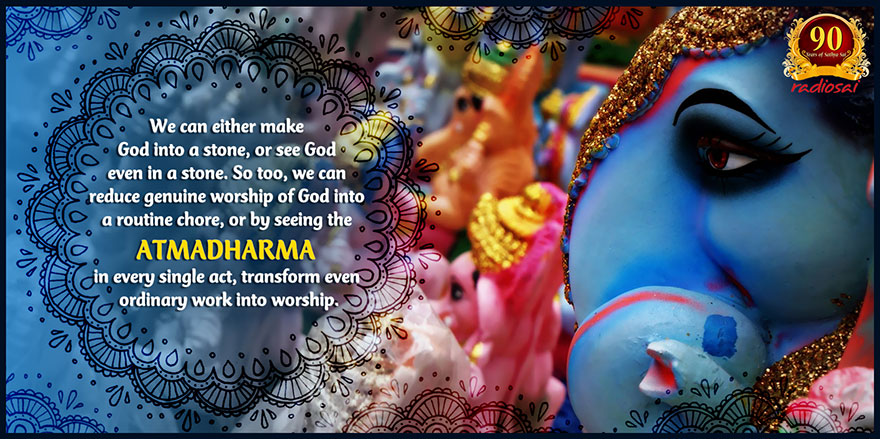 |
I hope all this helps you to understand why Swami says we must see God in the stone rather than the other way about. Keeping that in mind, let us proceed a bit further. To Swami once again, who says:
"So too, seeing the Atmadharma in every single act of yours transforms it into an act of worship, elevates it and removes its binding characteristic. If the duties of worldly life are done with no regard to genuine Sathya and Dharma, it is as unholy as treating God as stone."
This is an interesting quote. Swami says that just as we have the option of either making God into stone or seeing God in stone, so too, we can reduce genuine worship of God into a routine chore, or alternately, we can even make ordinary work into worship. When we do the latter, we are really following Atmadharma – that is in essence what Swami is saying. The question now becomes: “How does one convert routine work into worship?” That I shall may discuss later but meanwhile, I do hope I have not totally lost you and that you are with me at least part of the way!
See you again next time, and till then, God be with you. Till then, take care, and may God be with you. Jai Sai Ram.
Part 01 || Part 02 || Part 03 || Part 05 || Part 06
- Radio Sai Team
What do you think about this Musings? Please let us know by writing in to h2h@radiosai.org or you may leave your thoughts in the comments section. Do not forget to mention your name and country.
| comments powered by Disqus |






